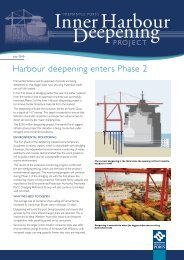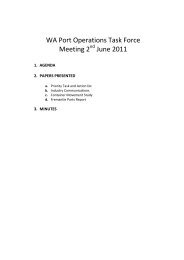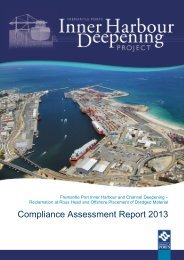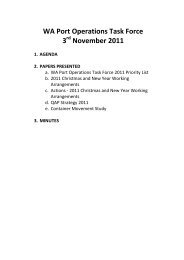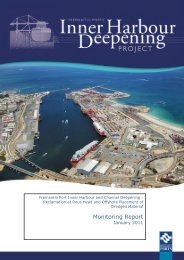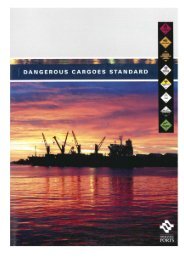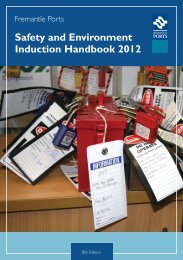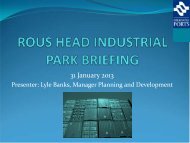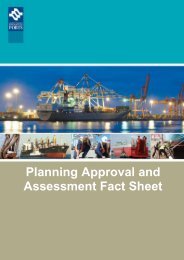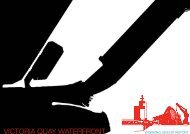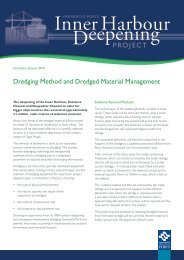IHD Engineering Awards submission - Fremantle Ports
IHD Engineering Awards submission - Fremantle Ports
IHD Engineering Awards submission - Fremantle Ports
Create successful ePaper yourself
Turn your PDF publications into a flip-book with our unique Google optimized e-Paper software.
Mandatory Judging Criteria<br />
Criteria 3:<br />
Originality and ingenuity of the solution<br />
<strong>Fremantle</strong> <strong>Ports</strong> opted to use an Early Contractor<br />
Involvement approach to plan the project before reverting to<br />
a series of lump sum contracts during the execution phase.<br />
The ECI phase involved preparing for the operation with<br />
three teams – <strong>Fremantle</strong> <strong>Ports</strong>, Thiess Georgiou JV and<br />
Boskalis Australia – over a six month period.<br />
Project Objectives and a Project Charter were jointly<br />
developed. The Charter was written into the preamble<br />
to the construction contracts to promote values of trust,<br />
respect and honesty.<br />
A Project Leadership Team (PLT) established during the ECI<br />
continued into the project delivery phase and monitored all<br />
project KPIs, working collaboratively to resolve any issues<br />
referred by the project management team.<br />
Throughout the project, continual improvement and<br />
professional development was facilitated through<br />
workshops and surveys.<br />
Another innovative practice adopted during the execution<br />
phase of the project was the undertaking of “Wellbeing<br />
Surveys” involving site and head office personnel to help<br />
identify early any potential problems in relationships and<br />
performance.<br />
Innovativeness of design, process<br />
or application<br />
<strong>Fremantle</strong> <strong>Ports</strong> manages its shipping operations with the<br />
aid of Dynamic Under Keel Clearance (DUKC©) 1 technology.<br />
to calculate the window of opportunity for ships to transit<br />
and exchange cargo in the port. In the planning phase,<br />
DUKC Technology was used to optimise channel design and<br />
minimise dredge depths.<br />
A series of real-time ship simulations was also undertaken<br />
to confirm navigational aspects of the design. These were<br />
performed in conjunction with <strong>Fremantle</strong> Pilots’ pilots using<br />
a full bridge simulator located in the port.<br />
The combined use of DUKC technology and ship simulations<br />
reduced the volume of dredging needed and provided the<br />
Harbour Master and marine pilots with confidence that<br />
the channel design and dredge depths could be safely<br />
navigated for larger ships.<br />
To cater for the heavier loads bigger ships impose on wharf<br />
infrastructure, the North Quay container berths required<br />
strengthening, and in the case of Berth 10, demolition and<br />
complete reconstruction.<br />
Although a relatively simple structure, the Berth 10<br />
reconstruction was complex due to the constrained site,<br />
access issues, working over or near water and coordinating<br />
multiple activities such as piling, concrete cutting and<br />
removal, precast installation and in situ concreting.<br />
The new berth design was tailored to avoid clashes with<br />
existing pile grids from remnant structures and the design<br />
was carried out maximising deck planks and thinning down<br />
1<br />
<strong>Fremantle</strong> <strong>Ports</strong> DUKC system is developed and operated by OMC International Pty Ltd



